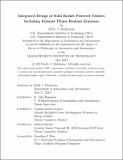Integrated Design of Solid Rocket Powered Vehicles Including Exhaust Plume Radiant Emission
Author(s)
Mathesius, Kelly J.
DownloadThesis PDF (15.94Mb)
Advisor
Hansman, R. John
Terms of use
Metadata
Show full item recordAbstract
For aircraft and rockets where vehicle visibility is a concern, exhaust plume radiant emission is an important aspect of solid rocket powered vehicle performance. However, it is often not considered during the design phase, despite significant couplings with other vehicle disciplines, especially propulsion. Considering plume radiant emission during the design phase is important for ensuring vehicle design constraints and objectives can be met while accounting for the coupling of plume radiant emission with other disciplines.
Technology gaps exist for integrating exhaust plume radiant emission in solid rocket powered vehicle design. Typical modeling approaches are computationally expensive, and rely on CFD and complicated integration schemes that are not well-suited for fast, iterative vehicle design. Existing data for solid rocket motor exhaust plume radiant emission is limited in the open-literature, and does not include measurements for small, low-thrust motors or propellants containing the burn rate suppressant oxamide. Few design guidelines exist for the integrated consideration of exhaust plume radiant emission in solid rocket motor design.
This thesis provides advancements and solutions for these technology gaps to enable design phase consideration of exhaust plume radiant emission. The effects of chamber pressure and propellant oxamide content on exhaust plume infrared radiant emission were measured for small, low-thrust, end-burning solid rocket motors. Static fires utilized motors that were operated at approximately 1 MPa to 2 MPa with ammonium perchlorate composite propellants that were doped with 0 or 8% oxamide. An end-to-end differentiable model for exhaust plume radiant emission was developed and implemented in the flexible AeroSandbox design optimization framework. The developed model shows reasonable agreement with measurements from this work and results from other studies, and is robust over eight orders of magnitude of plume radiant intensity.
The model is used to explore the couplings between vehicle thrust, chamber pressure, oxamide content, and exhaust plume radiant intensity for a small (< 3kg), low-thrust (5 N - 20 N), fast (> 100 m/s) solid rocket powered aircraft concept. For this class of vehicles, it was found that a large range of radiant intensities can be achieved for a given thrust requirement by varying the motor oxamide content and chamber pressure. Additionally, the effects of motor size scale on the progression of afterburning kinetics and plume radiant emission is explored and quantified; for sufficiently small motors and plumes, it was found that the excess fuel in the plume remains largely unburnt, which reduces the plume radiant intensity.
The experimental data, practical modeling tools, and design guidelines developed in this thesis support the design phase consideration of exhaust plume radiant emission in solid rocket motor design. For vehicles where visibility is important, considering exhaust plume radiant emission during vehicle design enables a better understanding of motor design and performance tradeoffs and supports improved motor performance.
Date issued
2023-06Department
Massachusetts Institute of Technology. Department of Aeronautics and AstronauticsPublisher
Massachusetts Institute of Technology